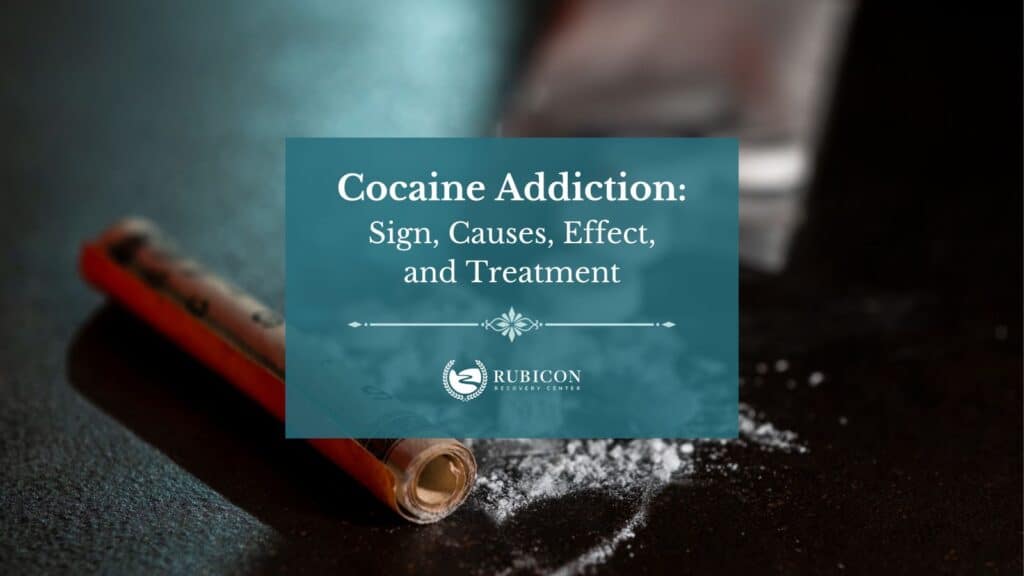Cocaine addiction is characterized by increased energy, euphoria, paranoia, and financial problems. Causes include genetic predisposition, environmental factors, and social influences. Effects include physical health deterioration, mental health disorders, relationship strains, financial ruin, and legal issues. Seek professional help for addiction recovery.
According to the National Survey on Drug Use and Health (NSDUH) in the United States, in 2019, approximately 5.5 million people aged 12 or older reported using cocaine in the past year. The Drug Abuse Warning Network (DAWN) reported that in 2011, there were approximately 505,224 emergency department visits in the United States related to cocaine use.
Treatment options for cocaine addiction include behavioral therapies, such as cognitive-behavioral therapy (CBT) and contingency management, to address underlying issues and promote sobriety. Medications, such as disulfiram and topiramate, are also used in some cases. Support groups and residential treatment programs can provide additional support and structure.
What is cocaine?
Cocaine is a powerful stimulant drug that is derived from the coca plant. It comes in the form of a white powder that is snorted, injected, or smoked. Cocaine acts on the central nervous system, producing euphoria, increased energy, and heightened alertness. However, it also carries significant risks, including addiction, cardiovascular problems, and negative effects on mental health. It is classified as a Schedule II controlled substance due to its high potential for abuse and addiction.
When is someone addicted to cocaine?
Someone is considered addicted to cocaine when they exhibit a pattern of compulsive drug-seeking and drug use despite negative consequences. The Diagnostic and Statistical Manual of Mental Disorders (DSM-5) outlines criteria for diagnosing a substance use disorder, including cocaine addiction.
These criteria include exhibiting signs such as a strong desire to use cocaine, difficulty controlling or reducing use, spending significant time obtaining or recovering from its use, neglecting important obligations, and experiencing withdrawal symptoms when not using.
Signs of Cocaine Use or Addiction?
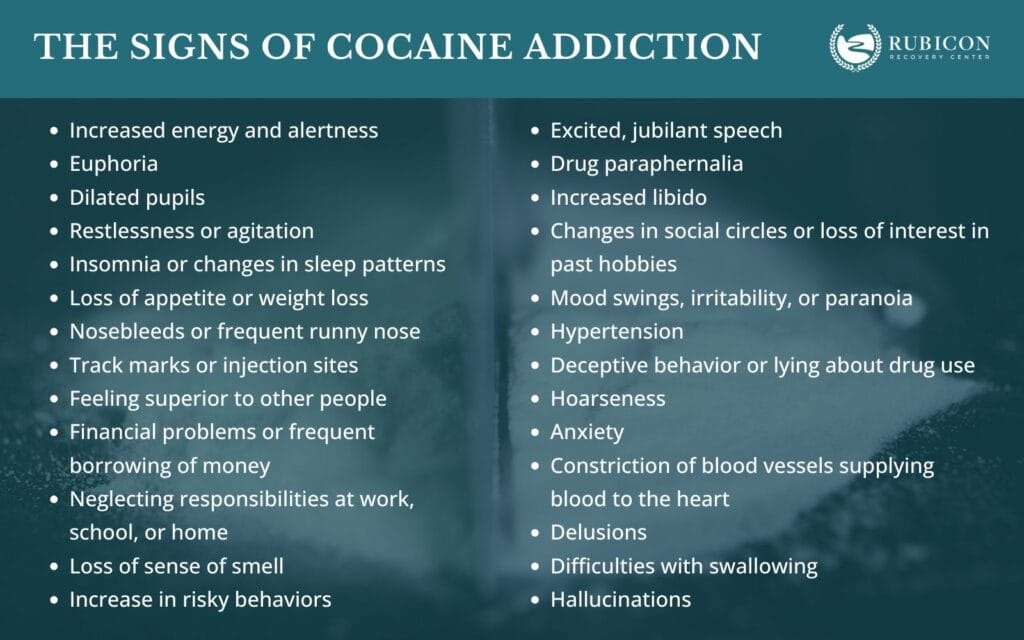
The signs of cocaine addiction include:
- Increased energy and alertness: Noticeable rise in energy levels and heightened state of alertness.
- Euphoria: One of the immediate effects of cocaine is a sense of intense pleasure and euphoria.
- Dilated pupils: Enlarged pupils, often referred to as “puppy eyes” due to their black appearance.
- Restlessness or agitation: Exhibiting signs of unease, irritability, or an inability to stay still.
- Insomnia or changes in sleep patterns: Difficulty falling asleep or experiencing alterations in regular sleep routines.
- Loss of appetite or weight loss: Decreased desire to eat or unintended weight reduction.
- Nosebleeds or frequent runny nose (if snorting cocaine): Bleeding from the nose or persistent nasal discharge.
- Track marks or injection sites (if injecting cocaine): Visible marks or scars at injection points on the body.
- Feeling superior to other people: Cocaine can induce feelings of grandiosity, leading individuals to feel superior or invincible compared to others.
- Financial problems or frequent borrowing of money: Facing financial difficulties or repeatedly seeking loans.
- Neglecting responsibilities at work, school, or home: Failing to fulfill obligations in various areas of life.
- Loss of sense of smell: Prolonged cocaine use can result in a loss of sense of smell, known as anosmia.
- Increase in risky behaviors: Cocaine use is associated with engaging in risky behaviors, such as reckless driving, unprotected sex, or involvement in criminal activities.
- Excited, jubilant speech: Cocaine use often results in rapid and animated speech patterns.
- Drug paraphernalia: The presence of drug-related paraphernalia, such as pipes, straws, or small baggies, may indicate cocaine use.
- Increased libido: Cocaine use can heighten sexual desire and lead to increased libido.
- Changes in social circles or loss of interest in previously enjoyed activities: Shifts in friendships and disinterest in once-enjoyed hobbies.
- Mood swings, irritability, or paranoia: Frequent changes in mood, irritability, or unfounded feelings of suspicion.
- Hypertension: Cocaine can raise blood pressure levels, leading to hypertension.
- Deceptive behavior or lying about drug use: Engaging in dishonesty or hiding drug-related activities.
- Hoarseness: Cocaine abuse can lead to hoarseness or changes in voice quality.
- Anxiety: Cocaine use can lead to heightened anxiety and restlessness, often accompanied by paranoia.
- Constriction of blood vessels supplying blood to the heart: Cocaine can cause constriction of blood vessels supplying the heart, increasing the risk of heart-related complications.
- Delusions: In some cases, cocaine use can trigger delusions, causing individuals to have false beliefs or perceptions.
- Difficulties with swallowing: Cocaine can cause throat constriction, making swallowing difficult.
- Hallucinations: Cocaine-induced hallucinations may involve seeing or hearing things that are not real.
These signs vary from person to person, and it’s important to remember that addiction is a complex condition that affects individuals differently.
What Causes Cocaine Addiction?
Cocaine addiction is influenced by the following factors:
1. Genetics
Certain genetic variations increase the vulnerability to addiction. Studies have shown that genes play a role in how the brain responds to cocaine, including the release and reabsorption of dopamine, a neurotransmitter associated with pleasure and reward. A study by Aldo Badiani et al, titled Role of environmental factors in cocaine addiction suggested that genetic factors play a role in the susceptibility to cocaine addiction. Certain genetic variations increase the risk of developing an addiction.
2. Brain Chemistry
Cocaine affects the brain’s reward system by increasing dopamine levels. With repeated use, the brain adapts, becoming less sensitive to natural rewards and relying on cocaine to trigger dopamine release. This leads to a cycle of craving and dependence.
3. Environmental Factors
The environment in which a person grows up and lives influences the risk of developing cocaine addiction. Factors such as peer pressure, exposure to drug use, family dynamics, and socioeconomic status can contribute to the initiation and maintenance of drug use.
4. Childhood Trauma
Adverse experiences during childhood, such as physical, emotional, or sexual abuse, neglect, or household dysfunction, can increase the likelihood of substance abuse, including cocaine addiction. Trauma can lead to self-medication with drugs as a coping mechanism.
A study by Hyman et al, titled Severity of Childhood Trauma is Predictive of Cocaine Relapse Outcomes in Women but not Men found that the severity of childhood trauma, including emotional abuse, sexual abuse, physical abuse, and overall trauma, was associated with the frequency and amount of cocaine use in women.
5. Co-occurring Mental Health Disorders
Individuals with underlying mental health conditions, such as depression, anxiety, or attention-deficit hyperactivity disorder (ADHD), may be more susceptible to cocaine addiction. Drugs like cocaine may temporarily alleviate symptoms, leading to self-medication and eventual addiction.
6. Peer Influence
Peer pressure and social influence play a significant role in drug experimentation and addiction. The desire to fit in or be accepted by a particular group can lead to the initiation and continued use of cocaine.
7. Stress
High levels of stress, whether related to work, relationships, or other life circumstances, can increase the risk of cocaine addiction. Cocaine’s stimulant effects may provide temporary relief from stress and serve as a coping mechanism.
8. Lack of Adequate Support and Treatment
Insufficient support and limited access to appropriate treatment services contributes to the development and continuation of cocaine addiction, as individuals facing addiction may struggle to find the necessary assistance and resources to address their substance abuse and embark on the path to recovery.
9. Early Use
Early use of cocaine is a risk factor for developing addiction later in life, as the developing brain is more vulnerable to the drug’s effects. Exposing the brain to cocaine during critical stages of development increases the likelihood of long-term changes that lead to addictive behaviors and substance abuse disorders.
What are the Withdrawal Symptoms of Cocaine?
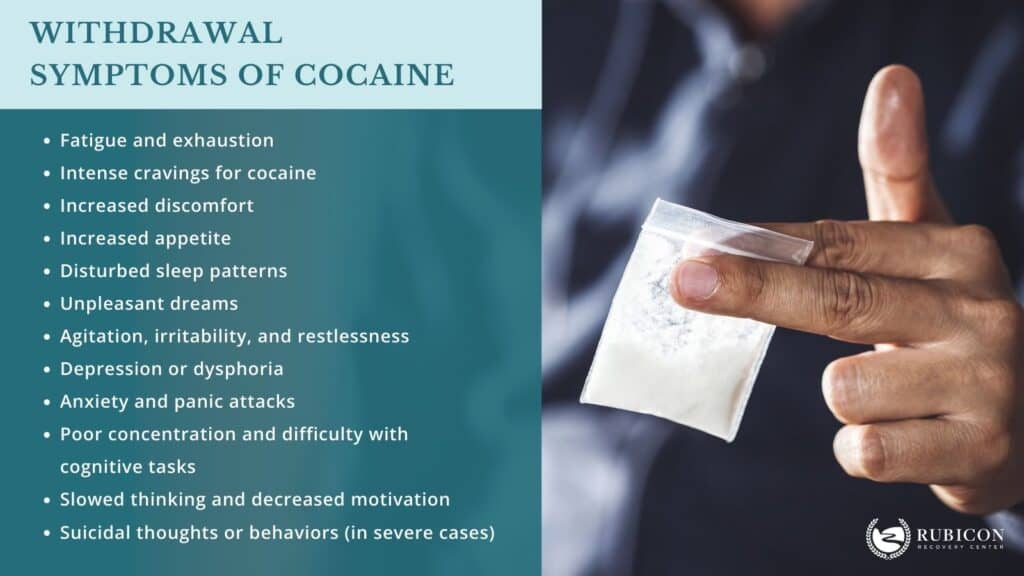
The withdrawal symptoms of cocaine addiction vary in intensity and duration, but include:
- Fatigue and exhaustion
- Intense cravings for cocaine
- Increased discomfort
- Increased appetite
- Disturbed sleep patterns
- Unpleasant dreams
- Agitation, irritability, and restlessness
- Depression or dysphoria
- Anxiety and panic attacks
- Poor concentration and difficulty with cognitive tasks
- Slowed thinking and decreased motivation
- Suicidal thoughts or behaviors (in severe cases)
What are the Effects of Cocaine Addiction on a Cocaine User?
Here are some of the effects associated with cocaine addiction:
What are the Short-Term Effects of Cocaine Addiction?
- Intense euphoria, increased energy, and alertness: Cocaine addiction causes individuals to seek intense pleasure, experience heightened energy levels, and exhibit increased alertness and hyperactivity.
- Cardiovascular effects: Cocaine stimulates the cardiovascular system, leading to elevated heart rate, increased blood pressure, and constricted blood vessels, which can reduce blood flow to organs and increase the risk of cardiovascular problems.
- Physical symptoms: Cocaine use can result in dilated pupils and decreased appetite due to the drug’s stimulant effects.
- Psychological symptoms: Cocaine addiction can manifest as restlessness, insomnia, irritability, aggression, paranoia, anxiety, and impaired judgment, leading to risky behaviors.
What are the Long Term Effects of Cocaine Addiction?
- Physical health consequences: Long-term cocaine use can lead to cardiovascular problems (heart attack, stroke, heart disease), respiratory issues (nasal damage, congestion, nosebleeds), weight loss, dental problems, weakened immune system, and overall physical health deterioration.
- Mental health disorders and cognitive impairment: Cocaine addiction is associated with an increased risk of mental health disorders such as depression, anxiety, and psychosis. Prolonged use can also result in cognitive impairments, including attention deficits, memory problems, and difficulties with decision-making.
- Social and relationship problems: Addiction to cocaine can strain relationships due to trust issues, conflicts, and the prioritization of drug use over personal connections. Individuals may also isolate themselves from sober friends, leading to social isolation.
- Financial and legal consequences: Sustaining a cocaine addiction often leads to financial difficulties, including debt, loss of employment, and legal issues. Cocaine possession, distribution, or trafficking can result in criminal charges, fines, probation, or imprisonment.
- Overdose risk: Cocaine overdose is a severe risk for individuals with addiction, potentially leading to life-threatening symptoms such as cardiac arrest and respiratory failure.
Why Do People Use Cocaine?
Reasons why individuals use cocaine include:
- Pleasure and euphoria
- Increased energy and alertness
- Social and recreational purposes
- Curiosity and experimentation
- Self-medication for emotional issues
- Performance enhancement
- Escapism and coping with problems
- Addiction and dependence
How Does Cocaine Addiction Impact the Lungs, Leading to Lung Damage?
Cocaine addiction can lead to lung damage through various mechanisms. Smoking crack cocaine exposes the lungs to toxic fumes, causing inflammation, bronchospasm, and chronic cough. Additionally, cocaine use can constrict blood vessels, reducing oxygen supply to the lungs and potentially leading to tissue damage, infections, and respiratory complications such as pneumonia or pneumothorax.
What are the Mental and Cognitive Health Effects of Cocaine Addiction?
- Addiction and dependence: Cocaine is highly addictive, and repeated use leads to physical and psychological dependence.
- Mood disorders: Cocaine abuse contributes to the development or exacerbation of mood disorders such as depression, anxiety, and bipolar disorder.
- Psychosis: Some drug addicts will experience cocaine-induced psychosis, characterized by hallucinations, delusions, and paranoia.
- Cognitive impairment: Prolonged cocaine use impairs cognitive functions such as attention, memory, decision-making, and impulse control.
How Does Cocaine Affect the Brain?
Cocaine affects the brain by increasing the levels of dopamine, a neurotransmitter associated with pleasure and reward, in the brain’s reward pathway. This leads to intense feelings of euphoria and stimulation. Over time, repeated cocaine use can disrupt the normal functioning of the brain’s reward system, impair decision-making, increase the risk of addiction, and contribute to cognitive deficits and changes in emotional regulation.
What are the Behavioral, Social, and Interpersonal Effects of Cocaine Addiction?
- Relationship problems: Cocaine addiction strains relationships with family, friends, and romantic partners due to behavioral changes, dishonesty, and prioritizing drug use over personal connections.
- Legal and financial issues: The cost of cocaine and associated legal consequences, such as arrests and fines, leads to financial instability and legal problems.
- Occupational difficulties: Cocaine addiction results in reduced work performance, absenteeism, and job loss.
A publication by UNC Health revealed that Long-term cocaine use disrupts communication between major brain networks, such as the default mode network (DMN), the salience network (SN), and the lateral cortical network (LCN). This disruption makes it harder for individuals to focus, control impulses, and feel motivated without the drug, impacting their ability to respond to everyday situations
Overall Quality of Life
Cocaine addiction has a profound negative impact on an individual’s overall quality of life, leading to social isolation, loss of interest in previously enjoyed activities, and a diminished sense of purpose and fulfillment.
Note that the effects of cocaine addiction vary among individuals, and the severity of these effects depends on factors like the duration and intensity of drug use, individual susceptibility, and the presence of co-occurring disorders.
What are the Treatment Options for Cocaine Addiction?
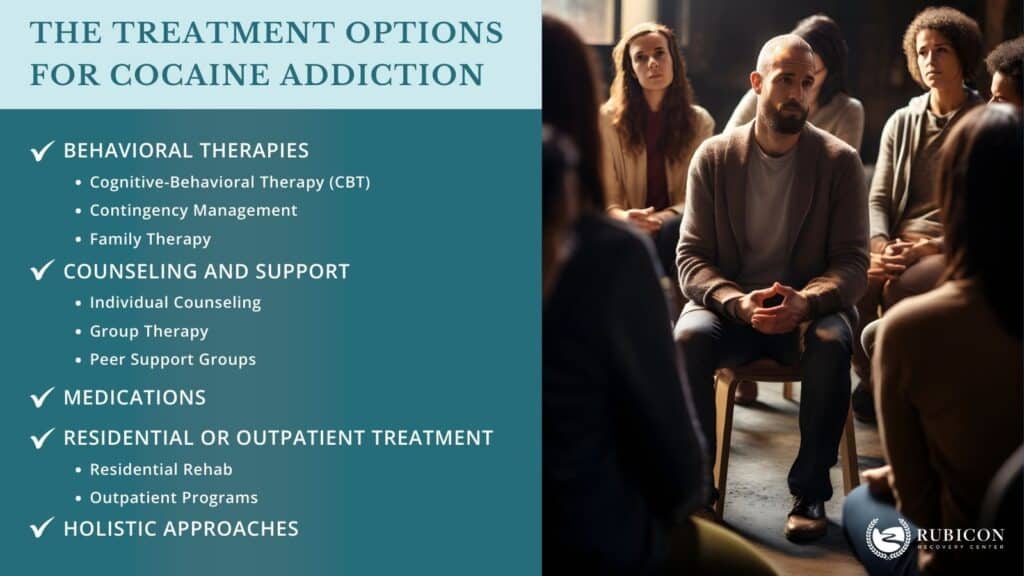
Here are the treatment approaches for cocaine addiction:
1. Behavioral Therapies
- Cognitive-Behavioral Therapy (CBT): Research by K M Carroll, titled Cognitive-Behavioral Approach: Treating Cocaine Addiction; Manual 1 showed that CBT is a widely recognized and effective approach for treating cocaine addiction. It helps individuals identify and modify negative thought patterns and behaviors associated with drug use.
- Contingency Management: Incentivizes abstinence by providing rewards or vouchers for negative drug tests or engaging in treatment-related activities.
- Motivational Interviewing: A client-centered approach that aims to enhance motivation and commitment to change by exploring and resolving ambivalence about drug use.
- Family Therapy: Involves the individual’s family members to address family dynamics, improve communication, and provide support for recovery.
2. Counseling and Support
- Individual Counseling: One-on-one therapy sessions to explore underlying issues, develop coping strategies, and work towards recovery goals.
- Group Therapy: Participating in therapy sessions with others facing similar challenges, providing support, and sharing experiences.
- Peer Support Groups: Joining groups like Cocaine Anonymous (CA) or Narcotics Anonymous (NA) for ongoing support and guidance from individuals in recovery.
3. Medications
There is currently no FDA-approved medication specifically for cocaine addiction. However, some medications may be used off-label to address specific symptoms or co-occurring disorders. For example, medications for depression or anxiety may be prescribed if present.
4. Residential or Outpatient Treatment
- Residential Rehab: Inpatient programs that provide intensive, 24-hour care, including therapy, medical supervision, and a structured environment away from triggers.
- Outpatient Programs: Flexible treatment options that allow individuals to live at home while attending therapy sessions, counseling, and support groups.
5. Holistic Approaches
Complementary and alternative therapies, such as mindfulness practices, yoga, acupuncture, and art therapy, can be integrated into treatment to promote overall well-being and stress reduction.
According to research by Kathy T Breslin et al, titled An holistic approach to substance abuse treatment holistic therapies like Acupuncture are believed to help reduce cravings, alleviate withdrawal symptoms, and promote relaxation and overall well-being. The study suggests that acupuncture has a positive impact on reducing cocaine use and improving treatment outcomes.
Treatment success often relies on a combination of approaches, ongoing support, and a commitment to long-term recovery.
Where to Find Treatment for Cocaine Addiction
You can find treatment for cocaine addiction in the following places:
- Inpatient Rehabilitation Centers: These residential treatment facilities provide intensive care and a structured environment to support recovery from cocaine addiction.
- Outpatient Treatment Centers: These centers offer flexible treatment options where individuals can attend therapy sessions, counseling, and support groups while living at home.
- Substance Abuse Clinics: These specialized clinics provide comprehensive assessment, treatment planning, counseling, and medication management for individuals with substance use disorders, including cocaine addiction.
- Mental Health Centers: Many mental health centers offer addiction treatment services and have professionals trained in addressing substance use disorders.
- Hospitals: Some hospitals have addiction treatment programs or departments that provide medical detoxification, counseling, and other forms of treatment for cocaine addiction.
- Private Practitioners: Individual therapists, counselors, or addiction specialists in private practice may offer tailored treatment plans and ongoing support for cocaine addiction.
- Support Groups: Organizations like Cocaine Anonymous (CA) or Narcotics Anonymous (NA) offer support group meetings where individuals can connect with others in recovery and find guidance.
- Online Resources: Various online platforms provide information, resources, and virtual support for individuals seeking treatment for cocaine addiction.
Consider location, cost, treatment approach, and individual needs when choosing a treatment option.
How to Treat Cocaine Overdose
If your loved one has overdosed on cocaine, below are the urgent steps to take:
- Call for Emergency Medical Assistance: Dial emergency services or go to the nearest emergency room quickly.
- Provide Supportive Care: Ensure the person’s airway is clear and monitor their vital signs, including breathing, heart rate, and blood pressure. Administer CPR if necessary.
- Stabilize Breathing and Circulation: In severe cases, medical professionals may assist with assisted ventilation or administer medications to address respiratory distress, seizures, or irregular heart rhythms.
- Monitor and Manage Symptoms: Medical staff will monitor the individual’s condition closely, treating symptoms as they arise. This may include administering medications to control agitation, seizures, or hypertension.
- Provide Psychological Support: Reassure and comfort the person during the treatment process, as they may experience anxiety, confusion, or distress.
- Obtain a Comprehensive Medical Evaluation: Once stabilized, the person will typically undergo a full medical assessment to identify any underlying health issues and discuss the potential need for further treatment or counseling.
Remember that treating a cocaine overdose requires professional medical intervention. Prompt action and seeking emergency medical assistance are essential for the best chance of recovery.
What are the Different Forms of Cocaine?
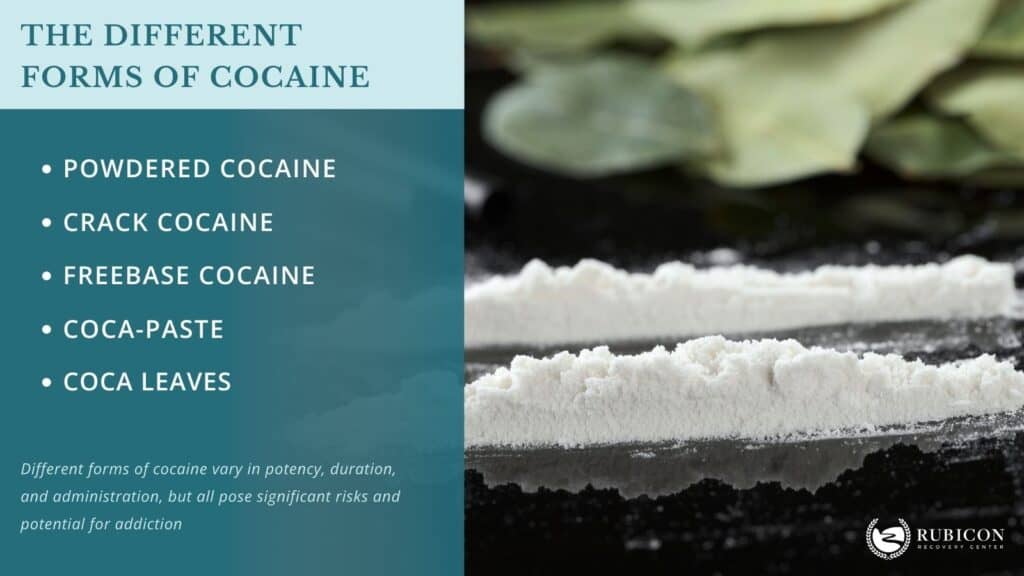
The different forms of cocaine include:
- Powdered Cocaine: Also known as “coke” or “blow,” it is a fine, white powder that is typically snorted through the nose. It can also be dissolved and injected intravenously.
- Crack Cocaine: Crack is a solid, crystal-like form of cocaine that is processed with baking soda or ammonia and water. It is usually smoked in a pipe or heated on foil and inhaled.
- Freebase Cocaine: Freebase cocaine is a purer form of cocaine that is chemically processed to remove impurities. It is typically smoked.
- Coca-Paste: Coca-paste is an intermediate form of cocaine that is derived from coca leaves. It is typically processed further to produce powdered cocaine or converted into other forms like crack.
- Coca Leaves: In their natural form, coca leaves contain small amounts of cocaine alkaloids. Traditionally, coca leaves have been chewed or brewed into tea in some indigenous cultures for their stimulant effects.
These different forms of cocaine vary in potency, duration of effects, and methods of administration. It’s important to note that all forms of cocaine carry significant risks and potential for addiction and should be avoided.
What are the Different Slang Names for Cocaine?
Cocaine is known by various slang names, which can vary based on region and subculture. Here are some common slang names for cocaine:
- Coke
- Blow
- Snow
- Powder
- Charlie
- Nose candy
- White
- Yayo
- C
- Flake
- Toot
- Dust
- Rock
- Crack
- Base
What Are the Facts and Statistics on the Prevalence of Cocaine Addiction?
Here are some key facts and statistics on the prevalence of cocaine addiction:
How Many People Use Cocaine Worldwide?
According to the United Nations Office on Drugs and Crime (UNODC), an estimated 18 million people worldwide used cocaine in 2019.
How Many People Use Cocaine in the United States
In the United States, the National Survey on Drug Use and Health (NSDUH) reported that in 2020, approximately 5.5 million people aged 12 or older had used cocaine in the past year, representing 2% of the population.
Cocaine Use Disorder: The Diagnostic and Statistical Manual of Mental Disorders (DSM-5) estimates that about 15-20% of individuals who use cocaine develop a cocaine use disorder, which is characterized by addiction or problematic patterns of use.
Age and Gender
Cocaine use tends to be higher among young adults, with the highest rates seen in the 18-25 age group. Men have historically shown higher rates of cocaine use compared to women, although this gap has been closing in recent years.
How Many Cocaine Overdose Deaths Happen Yearly?
Overdose Deaths: Cocaine overdose can be fatal. Data from the Centers for Disease Control and Prevention (CDC) indicate that in the United States, cocaine was involved in over 16,000 overdose deaths in 2019.
Where and How is Cocaine Manufactured and Produced?
Cocaine is derived from the coca plant, which is native to South America. The production process typically takes place in regions where coca cultivation is prevalent, such as Colombia, Peru, and Bolivia. Here is an overview of the cocaine manufacturing process:
1. Coca Leaf Harvesting: Mature coca leaves are manually harvested from coca plants. The leaves contain alkaloids, including cocaine.
2. Coca Leaf Processing: The harvested leaves are typically soaked in a mixture of gasoline or another solvent to extract the alkaloids. This process results in the production of coca paste, which is a crude form of cocaine.
3. Cocaine Extraction: The coca paste undergoes further processing to extract and purify the cocaine alkaloid. Chemical solvents, such as acetone or ether, are used to remove impurities and produce a concentrated cocaine solution.
4. Cocaine Hydrochloride Production: The concentrated cocaine solution is mixed with hydrochloric acid, resulting in the formation of a solid, crystalline powder known as cocaine hydrochloride. This is the most common form of cocaine encountered on the market.
5. Cocaine Conversion: Some of the cocaine hydrochloride may undergo additional chemical processes to convert it into other forms, such as crack cocaine or freebase cocaine, which have different properties and methods of use.
What Are The Law Enforcement Efforts and Legal Implications of Cocaine
In the United States, law enforcement efforts against cocaine involve various strategies to combat drug trafficking and distribution. These efforts include interagency cooperation, intelligence gathering, surveillance, and targeted investigations to dismantle drug networks.
The legal implications of cocaine possession, trafficking, and distribution are significant. Possession of cocaine can lead to criminal charges, varying in severity based on the quantity involved. Trafficking and distribution offenses carry more severe penalties, including lengthy prison sentences and hefty fines.
The U.S. government also employs asset forfeiture laws to seize assets acquired through illegal drug activities. Sentencing guidelines aim to address the seriousness of cocaine offenses, with penalties varying based on factors such as prior convictions, quantity, and involvement in organized crime.
What are the potential challenges or setbacks in cocaine addiction recovery?
Potential challenges or setbacks in cocaine addiction recovery include intense cravings for the drug, triggers, and temptations in the environment, co-occurring mental health disorders, social pressure, relapse, and difficulty maintaining motivation and commitment to sobriety.
It’s important for individuals in recovery to have a strong support system, engage in ongoing therapy, and develop coping strategies to navigate these challenges successfully.
What are the relapse prevention strategies for individuals recovering from cocaine addiction?
Relapse prevention strategies for individuals recovering from cocaine addiction are:
- Identifying and avoiding triggers.
- Building a strong support network.
- Developing healthy coping mechanisms.
- Engaging in ongoing therapy and counseling.
- Practicing self-care, stress reduction, and healthy lifestyle habits.
- Setting realistic goals and celebrating milestones.
- Regularly attending support groups.
- Maintaining open communication with healthcare professionals and seeking help when needed.
How does peer influence contribute to cocaine addiction?
Peer influence contributes to cocaine addiction in several ways. Peer pressure leads individuals to experiment with drugs, including cocaine, to fit in or be accepted. Observing peers engaging in drug use normalizes the behavior and increases the likelihood of continued use. Peer networks involved in drug use create an environment where drug availability and social reinforcement for drug use are prevalent, further reinforcing addictive behaviors.
Get help with Your Cocaine Addiction in New Jersey
If you or someone you know is struggling with cocaine addiction in New Jersey, don’t face it alone. Rubicon Recovery Center is here to help you on your journey to recovery with our cocaine rehab program in New Jersey. Our team specializes in addiction treatment and provides comprehensive services tailored to meet your needs.
From medically supervised detoxification to evidence-based therapies and ongoing support, we are committed to guiding you toward lasting recovery. Take the first step towards a healthier and more fulfilling life by contacting Rubicon Recovery Center today.
Frequently asked questions
What is the difference between Cocaine and Meth?
Despite similarities, meth is man-made, and cocaine is plant-derived. Meth’s high lasts 8-24 hours, while cocaine’s lasts 20-30 minutes. Meth’s half-life is 12 hours, cocaine’s is one hour. Meth is neurotoxic, damaging serotonin and dopamine neurons, and increases dopamine release and blocks reuptake, unlike cocaine.
What happens if you mix Cocaine and Alcohol?
Mixing cocaine and alcohol masks intoxication, increasing the risk of overconsumption and alcohol poisoning. This combination creates cocaethylene, a toxic chemical that intensifies and prolongs cocaine’s effects while harming the heart and liver. It also heightens mental health risks, including suicide and violent behavior, and complicates addiction treatment.
Share This Post
